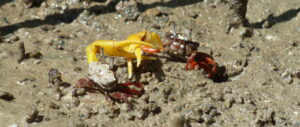Below are some current projects from the McCullough lab:
Ecology and evolution of urban dung beetles
Dung beetles play an essential role in maintaining healthy ecosystems. They degrade and bury animal waste, which aerates and restores nutrients to the soil, promotes plant growth, controls populations of dung-dwelling flies and parasites, and improves soil structure. The benefits of these ecosystem services are estimated at $5.9 billion per year in the United States, so protecting dung beetle communities is ecologically and economically important. We are conducting field surveys to characterize the abundance and diversity of dung beetles in urban parks and forests in Massachusetts, including at Clark’s Hadwen Arboretum just half a mile from campus. One of the most abundant beetles from our pitfall traps is the tunneling species Onthophagus orpheus, a beautiful, iridescent beetle that is native to forested areas of the eastern United States. We are studying its evolutionary ecology and using it as a model to learn about the impact of urbanization on sexual selection and behavior.

Form and function of animal weapons
Animal weapons differ widely among species, but the drivers of this diversity remain poorly understood. Horns, antlers, and claws are “tools” that males use to pinch, pry, and strike opponents in combat, so the most intuitive explanation for weapon diversity is that it reflects structural adaptations to different fighting styles. That is, differences in the way males fight, or in where they fight, may favor corresponding changes in weapon form. Because weapons are used as tools, they can experience substantial stresses and strains during fights that ultimately cause them to break. We are studying the costs and consequences of weapon damage across the animal kingdom, and how the likelihood of breakage influences the evolution of fighting behavior within and among species. We also study the scaling relationships between weapon size and body size, and how these allometric patterns depend on the relative importance of physical fighting versus aggressive signaling. 
Reproductive physiology and the evolution of ejaculate-female interactions
Sexual selection in general, and post-mating sexual selection in particular, is a powerful engine of speciation due to the coevolution of male and female reproductive traits. In species with internal fertilization, successful reproduction depends on highly coordinated interactions between male and female reproductive proteins that occur within the female reproductive tract. These proteins are among the most rapidly evolving proteins in the animal kingdom, so coevolution between male and female reproductive proteins is expected to drive specific molecular interactions within species and reproductive incompatibilities between species. However, the nature of these interactions is understudied. In many species, sperm are also stored within the female’s reproductive tract for extended periods of time before being used for fertilization, and molecular contributions from females are essential for maintaining sperm motility and metabolism. Our research uses quantitative proteomics to study these ejaculate-female interactions and their importance in maintaining species boundaries and mediating reproductive outcomes.

